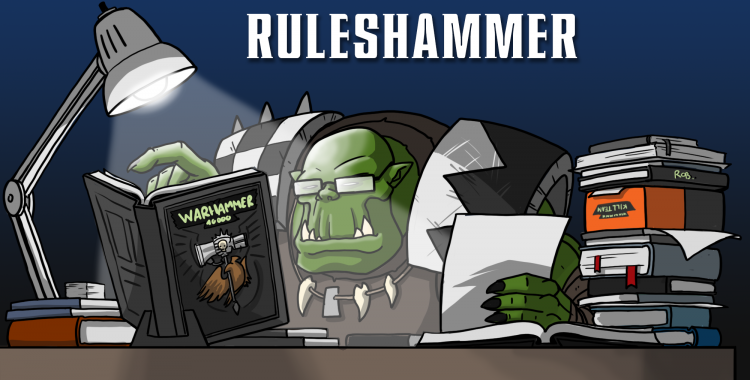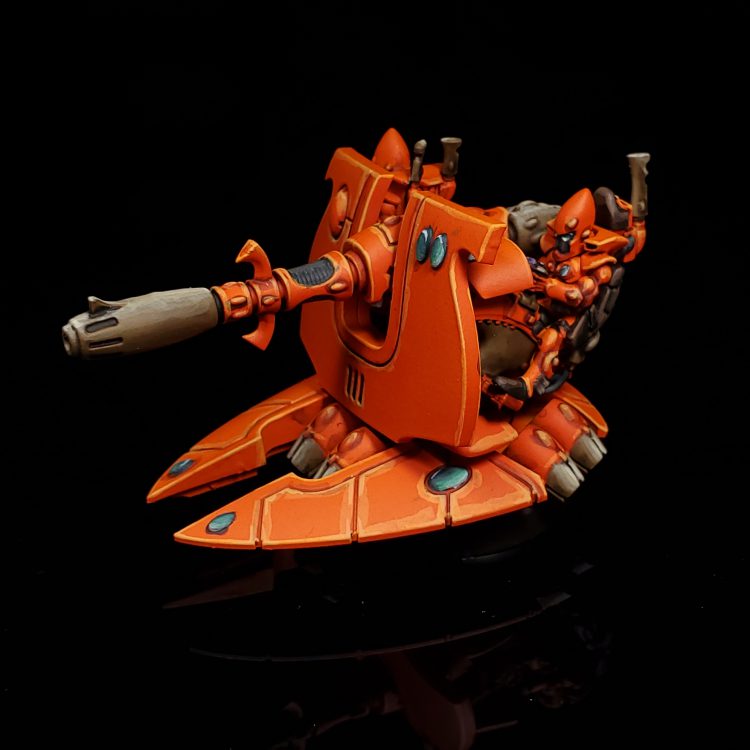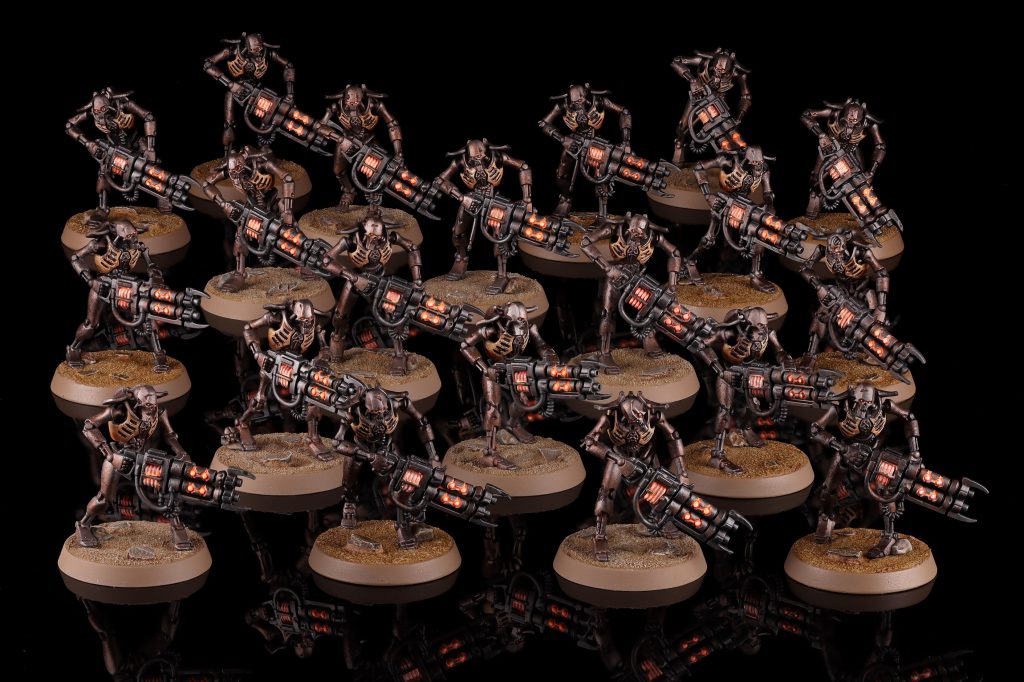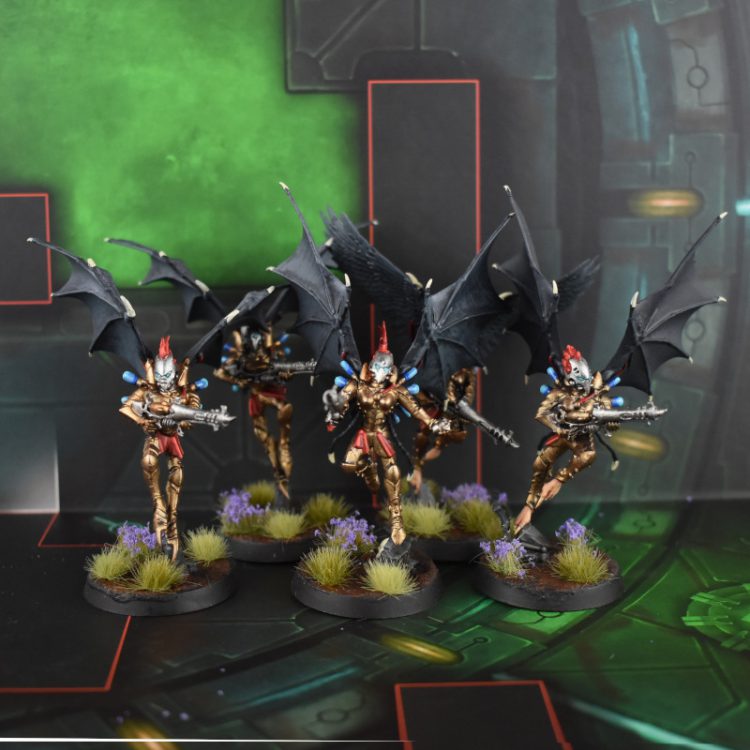Like Poirot, we turn to the camera for just one last thing, capping off all the Index rules you’ve been greedily devouring this week. Games Workshop have published the rules Glossary for 10th Edition, promoting this from a (welcome) section in the back of the printed rulebook to an online document that can be updated in a much more agile fashion.
Games Workshop sent us a review copy of this ahead of publication, so we’re going to dive in on two fronts – first asking “is this good” and second looking at the impacts the contents have.
Is it a Good Thing?

This is fantastic news for the game, both because it’s probably the best FAQ/glossary/commentary document Games Workshop has ever produced for 40K, and because of the shift it represents.
A living, online document is exactly where really detailed rules verbiage should live, as trying to keep a printed version up-to-date is impossible, and sets the bar for changes and updates too high. It also mirrors models used successfully in other games – in my opinion, this moves us closer to the way the Magic: the Gathering rules work, where the regular rules teach you how to play, and the comprehensive rules exist online to provide full legalese explaining why your local tryhard can’t do whatever they’re trying to do.
Here’s the paradoxical thing – by existing, this document ensures that most people don’t have to read it. Overwhelmingly, what this document is doing is saying “the rules work how you’d expect”, and they mean that if you just pick up your army and play some games, you’re probably doing it mostly right and aren’t going to have the rug pulled from under you at any moment. Sure there are a few things that you might need to go to look up – but that’s fine, you glance at it once, and then it’s done.
That frees up the level of detail and legalese in the printed rulebook to be turned down a notch from 9th Edition’s level (something that there was a notably negative reaction to), while ensuring there’s a fairly bulletproof ruleset in place to cater for the competitive crowd. Obviously we do still have a few outstanding questions, but a massive proportion of the things we came up with during the review process were already very clearly answered in this document, which is promising.
This starts us on a fantastic footing for 10th Edition’s rules robustness, and the future looks very bright indeed if Games Workshop keeps this up.
Key Rule Details

We are not going to go through this line by line, because it’s 18 pages long, and if you want to know everything it’s free online for you to read. It’s also written in very clear language – comprehensive, but clear. However, there’s a few things we want to pull out – the first few because they’re things the community has been in a frenzy about for weeks, then some where the rulings introduce some extra nuance that isn’t entirely evident from rules elsewhere.
The Big Ones
Yes, FLY Units Have to Go Around or Over Stuff Now

We will admit that this one we thought was pretty obvious from the rulebook, but there has been some serious straw clutching around the fact that the rulebook FLY rules only mention starting or ending a move on terrain, so maybe you could still magically wallhack through terrain.
Nope. FLY units have to go up and then down again if they’re crossing terrain during a move. There’s diagrams and everything.
Vre’kais: If there was a critique I had of this, it’s that Rules as Written the Core rules are even more restrictive. The glossary allows units to FLY to the top of a terrain piece it might not even be able to stand on and FLY back down. The core rules suggested that you can only measure a diagonal when starting or ending a move on terrain piece, so this is actually a softening of the restrictions.
No, You (Usually) Can’t Reduce Damage to 0
Rules that modify the damage of an attack cannot reduce it below 1 unless it is an ability that specifically sets the damage to 0. This qualifier used to appear on every individual damage reduction datasheet, so the fact that it’s been missing from the new ones has caused alarm. Please put down the flaming torches – it’s here, and now there’s no risk of the minimum being accidentally missed off a new datasheet like happened with Paragon Warsuits. Also, it’s a very healthy sign that they remembered not to break rules that work by setting damage to 0 while writing this.
Yes, Precision Works with Devastating Wounds
Probably unsurprising given that people can now see just how many sniper weapons have this combo, but yes if you score a Devastating Wound with a Precision weapon, you can choose to push the wounds into a visible Character in the target unit.
No, Devastating Wounds Does Not Bypass Damage Reduction

This is one of the important ones that genuinely wasn’t obvious from the rules alone – given a Devastating Wound doesn’t get allocated, would damage reduction effects work against it? Yes – which dials back the power of Devastating Wounds a little, and makes the rare damage-halving units like C’tan and the Avatar very spicy.
Yes, Units Have All the Keywords of Their Contents
Adding a Psyker Leader to a unit makes them vulnerable to Anti-Psyker weapons. Risk and reward, and all that. Note that that doesn’t mean that sticking a FLY character in a unit makes every model sprout wings – this is explored in exhaustive detail, so check if out if you have any concerns.
Vre’kais: This does lead to a few interesting combinations of keywords other than just FLY and PSYKER. There are INFANTRY leaders of VEHICLE units for instance, though some Indexes avoid this by giving the Character Lone Operative while close to the VEHICLE they’re meant to be with. Attaching a Datasmith to Kastellan Robots for instance makes the unit an INFANTRY unit and a VEHICLE unit.
Wings: …which is going to be very bad against Drukhari.
Yes, “That Target(s)” is Checked when you Choose Targets
All effects that apply conditionally to “target” units that meet certain criteria (e.g. closest, keywords, half-strength) are checked and locked in at the time targets are selected for attacks (so before any are resolved). No more slow rolling in case things change half way through, and it’s notable that there’s been a clear, conscious effort to minimise the situations where you can’t fast roll, with rules like this being part of it. Also, this was one of the most endless arguments in 9th, and I’m delighted to never have to have it again.
Vre’kais: So happy to have this debate over.
Yes, Leaders Get Their Own Buffs When They Lead

Effects that apply when a Leader is Leading a Unit do apply to the Leader themselves. They do not apply if the Leader no longer has a Bodyguard. This does create some slightly odd situations where a model gets considerably less good when their buddies die, but maybe they were very emotionally attached to them.
Vre’kais: I think some of the abilities lost when the Leader stops leading feel quite silly (I’m british, that was a devastating critique), for instance the Psychic Hood ability of most Space Marine Librarians is a Feel No Pain of 4+ vs Psychic attacks… which stops working when presumably the Librarian runs out of bodyguard units to telekinetically lift into the path of oncoming Psychic attacks.
No, Out of Phase Shooting Does Not Get “In Your Shooting Phase” Buffs
This one is worth flagging up because it’s a marked change from 9th Edition. In 9th, when you shot “as if it was your shooting phase”, all effects other than Stratagems that applied in your shooting phase would apply. Now they do not – which makes sense on some level, as shooting outside of phase is going to be far more common with new Overwatch, and also because a lot of the kind of Stratagem effects the old ruling stopped are now datasheet abilities. However, it’s definitely not intuitive from the plain language of the rules alone, so good to have clarified. Mercifully, it also stops you doing some heinously unpleasant things with Tyranid Spore Mine generators and Overwatch.
Vre’kais: I specifically dislike the language on this because it’s ONLY rules that specify “in the shooting phase” that stop working for an “as if the Shooting Phase” rule. If a rule just says “when this unit shoots” then that DOES trigger for an “as if the Shooting Phase” rule. I think this feels a bit backwards.
Yes, Toeing Into Cover is Really Bad
The document contains some great diagrams of how interacting with ruins works, and what they largely say is “yes, this works how it’s written”. That’s a good thing to have diagrammed out, but also creates a big change from 9th – you now want your models’ base to be wholly within a Ruin or not at all. If you’re partially within, enemies can see in to shoot you, but you still can’t see through the ruin out to shoot them. This is generally viewed as being tactically suboptimal by military experts.
No, Multiple Instances of Core Abilities Do Not Stack
If you somehow get multiple instances of Sustained Hits, only the best single value applies – two instances of Sustained Hits 1 does not work out as equivalent to Sustained Hits 2.
No, You Can’t Stack Infinite Leaders

Lots of abilities across the game let you add a second Leader to a unit. Most of these have verbiage that includes “one other”, but just to be safe (and to ward off accidentally leaving that off), there’s a safety valve in here saying you can never add a Leader after the second.
Yes, Skimmers Still Measure to Hull (But We Would Like Further Clarification)
This is one of the few items where we think a bit more explicit clarity and exploration of edge cases would be good, but hidden in the ruling on Base-to-Base is a clarification that yes, if a model’s hull overhangs the base such that you can’t easily get to the base, you measure to the hull, as is usually a datasheet ability in 9th.
How this interacts with things like planes and models that skew out over the side of the base in one direction could still do with some clarity, and we honestly can’t immediately think why a general rule of “VEHICLE models that are on any kind of flying base (excluding planes) always measure to hull” would be bad. It’s also unclear how this interacts with the requirement that to land on the upper floor of a ruin you have to be able to fit your whole base, because we could go either way on what the intent is here. This should also very definitely be its own separate entry, because people are going to argue about whether this applies a lot.
The Sneaky Ones
These are a few little points that are a bit more subtle – we haven’t seen them discussed much, but they matter quite a bit for some armies.
Reanimated Models

When reanimating (or otherwise adding) models into a unit, they have to be set up in coherency with models that were on the battlefield at the start of the phase. This means no more Necron conga lines extruding towards objectives.
End Of The Command Phase
Effects that happen at the End of the Command Phase are explicitly clarified to happen at the end of the Battle-shock step, so after tests are taken. Sorry Necron players, no reanimating models before checking Half Strength.
Starting Strength for Single-Model Units
This is referenced in some other rules (e.g. Chaos Knights) but it was unclear if it was a general ruling or a special “counts as” for those specific rules.
The Glossary clarifies that a single-model unit that has lost any wounds counts as below its starting strength. This considerably improves any ability that keys off this in both directions.
Strategic Reserves and Deep Strike
An interesting one – if an ability puts a unit into Strategic Reserves (which is how a lot of redeploy-style things now work) and that unit has Deep Strike, then when they return they can set up with that instead of following Strategic Reserves deployment rules. Quite a few of the places where this could happen already included this in their verbiage, but it’s worth keeping an eye out when reviewing your units.
Moving After Deep Striking

This, to be clear, is one that’s not here – nothing in the Core Rules stops you making moves later in a turn after Deep Striking, and nothing here does either. Obviously with the Psychic Phase gone and Stratagems being pricier this will come up less, but the small number of units with built in ways to do this (e.g. Drukhari Scourges) benefit massively from this.
Psychic Weapons can be used by Non-Pyskers
Vre’kais: I’m chiming in on this one because it annoyed me the most here at Goonhammer HQ. The Core rules specify that there “some weapons that can only be used by Pyskers” and that these weapons are labeled with the “PSYCHIC” tag. It goes on to explain that attacks with those weapons are considered Psychic Attacks. Well, the Glossary says that these weapons can by used by units that lack the PSYKER keyword. Which is good because there’s a bunch of units that lack it that only have Psychic weapons. It also clarifies that you can have a Rhino use a Psychic weapon via Firing Deck.
Wrap Up
Ultimately, in our esteemed positions as the community’s rules punching bags, every unclear rule causes us unceasing suffering, so we’re very, very grateful that Games Workshop have hit the ground running this edition. More of this sort of thing.


